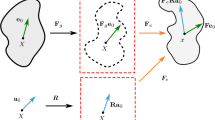Abstract
Early work on modeling the mechanical response of fibrous tissues suggested a structural model based on integration of angular distributions of fiber bundles over the surface of a unit sphere. This paper considers a discrete fiber model, based on a regular icosahedron with six fiber bundles defined by the twelve uniformly distributed vertices on a unit sphere. Like the structural model, the icosahedron model introduces a weighted sum of the strain energies of the six fiber bundles with parameters that characterize the density and strength of each fiber bundle as well as the undulation of the fibers in the bundle. It is shown that even when all fiber directions are identical and weighted evenly, this discrete model exhibits anisotropic response for large deformations. The reason for this anisotropic response is that the uncoupled strain energies of the fiber bundles do not allow for coupling of the strains in the fiber directions that are needed to form the principal invariants of strain. Anisotropic strain invariants based on structural tensors defined by a regular icosahedron model are discussed that can characterize isotropy and material anisotropy.



Similar content being viewed by others
References
Bažant, P., Oh, B.H.: Efficient numerical integration on the surface of a sphere. ZAMM-Journal of Applied Mathematics and Mechanics/Zeitschrift für Angewandte Mathematik und Mechanik 66(1), 37–49 (1986)
Bažant, Z.: Microplane model for strain controlled inelastic behaviour. In: Desai, C., Gallagher, R.H. (eds.) Mechanics of Engineering Materials, Ch. 3, pp. 45–59. Wiley (1984)
Chuong, C.J., Fung, Y.C.: Residual stress in arteries. In: Frontiers in Biomechanics, pp. 117–139. Springer (1986)
Ciambella, J., Nardinocchi, P.: A structurally frame-indifferent model for anisotropic visco-hyperelastic materials. J. Mech. Phys. Solids 147, 104247 (2021)
Ehret, A.E., Itskov, M., Schmid, H.: Numerical integration on the sphere and its effect on the material symmetry of constitutive equations—a comparative study. Int. J. Numer. Methods Eng. 81(2), 189–206 (2010)
Ehret, A.E., Itskov, M., Weinhold, G.: A viscoelastic anisotropic model for soft collageneous tissues based on distributed fiber–matrix units. In: IUTAM Symposium on Cellular, Molecular and Tissue Mechanics, pp. 55–65. Springer (2010)
Ehret, A.E., Itskov, M., Weinhold, G.W.: A micromechanically motivated model for the viscoelastic behaviour of soft biological tissues at large strains. Il Nuovo Cimento C-Geophys. Space Phys. 32(1), 73–80 (2009)
Elata, D., Rubin, M.B.: Isotropy of strain energy functions which depend only on a finite number of directional strain measures. ASME J. Appl. Mech. 61, 284–289 (1994)
Flory, P.J.: Thermodynamic relations for high elastic materials. Trans. Faraday Soc. 57(829–838) (1961)
Flynn, C., Rubin, M.B.: An anisotropic discrete fibre model based on a generalised strain invariant with application to soft biological tissues. Int. J. Eng. Sci. 60, 66–76 (2012)
Flynn, C., Rubin, M.B.: An anisotropic discrete fiber model with dissipation for soft biological tissues. Mech. Mater. 68, 217–227 (2014)
Flynn, C., Rubin, M.B., Nielsen, P.: A model for the anisotropic response of fibrous soft tissues using six discrete fibre bundles. Int. J. Numer. Methods Biomed. Eng. 27(11), 1793–1811 (2011)
Fung, Y.-C., et al.: Mechanical Properties of Living Tissues. vol. 547. Springer (1993)
Holzapfel, G.A., Gasser, T.C., Ogden, R.W.: A new constitutive framework for arterial wall mechanics and a comparative study of material models. J. Elast. Phys. Sci. Solids 61(1), 1–48 (2000)
Holzapfel, G.A., Niestrawska, J.A., Ogden, R.W., Reinisch, A.J., Schriefl, A.J.: Modelling non-symmetric collagen fibre dispersion in arterial walls. Journal of the Royal Society Interface 12(106), 20150188 (2015)
Holzapfel, G.A., Ogden, R.W.: Constitutive modelling of arteries. Proc. R. Soc. A: Math. Phys. Eng. Sci. 466(2118), 1551–1597 (2010)
Holzapfel, G.A., Ogden, R.W., Sherifova, S.: On fibre dispersion modelling of soft biological tissues: a review. Proc. R. Soc. A 475(2224), 20180736 (2019)
Itskov, M.: On the accuracy of numerical integration over the unit sphere applied to full network models. Comput. Mech. 57(5), 859–865 (2016)
Itskov, M., Ehret, A.E.: A universal model for the elastic, inelastic and active behaviour of soft biological tissues. GAMM-Mitteilungen 32(2), 221–236 (2009)
Itskov, M., Ehret, A.E., Dargazany, R.: A full-network rubber elasticity model based on analytical integration. Math. Mech. Solids 15(6), 655–671 (2010)
Lanir, Y.: Rheological behavior of the skin-experimental results and a structural model. In: Biorheology, vol. 15, pp. 454–454 (1978)
Lanir, Y.: Constitutive equations for fibrous connective tissues. J. Biomech. 16(1), 1–12 (1983)
Lanir, Y., Fung, Y.C.: Two-dimensional mechanical properties of rabbit skin–I. Experimental system. J. Biomech. 7(1), 29–34 (1974)
Lanir, Y., Fung, Y.C.: Two-dimensional mechanical properties of rabbit skin–II. Experimental results. J. Biomech. 7(2), 171–182 (1974)
Limbert, G.: Mathematical and computational modelling of skin biophysics: a review. Proc. R. Soc. A: Math. Phys. Eng. Sci. 473(2203), 20170257 (2017)
Miehe, C., Göktepe, S., Lulei, F.: A micro-macro approach to rubber-like materials—part i: the non-affine micro-sphere model of rubber elasticity. J. Mech. Phys. Solids 52(11), 2617–2660 (2004)
Raz, E., Lanir, Y.: Recruitment viscoelasticity of the tendon. J. Biomech. Eng. 131(11), 111008 (2009)
Rubin, M.B., Ehret, A.E.: Invariants for rari-and multi-constant theories with generalization to anisotropy in biological tissues. J. Elast. 133(1), 119–127 (2018)
Verron, E.: Questioning numerical integration methods for microsphere (and microplane) constitutive equations. Mech. Mater. 89, 216–228 (2015)
Acknowledgments
The author would like to acknowledge comments of Y Lanir which were used to improve this paper.
Author information
Authors and Affiliations
Corresponding author
Ethics declarations
Conflict of interest
The author declares no competing interests.
Additional information
Data availability
Data sharing is not applicable to this article as no datasets were generated or analyzed during the current study.
Publisher’s note
Springer Nature remains neutral with regard to jurisdictional claims in published maps and institutional affiliations.
Appendix.: Geometry of the discrete icosahedron fiber model
Appendix.: Geometry of the discrete icosahedron fiber model
1.1 A.1 Geometry of a regular icosahedron
The six unit vectors NI parallel to the directions of opposing vertices of a regular icosahedron are defined by the
Also, the symmetric matrix βIJ in (6) is given by
Rights and permissions
About this article
Cite this article
Rubin, M.B. Anisotropy of a discrete fiber icosahedron model for fibrous tissues exhibited for large deformations. Mech Soft Mater 4, 2 (2022). https://doi.org/10.1007/s42558-022-00040-7
Received:
Accepted:
Published:
DOI: https://doi.org/10.1007/s42558-022-00040-7




